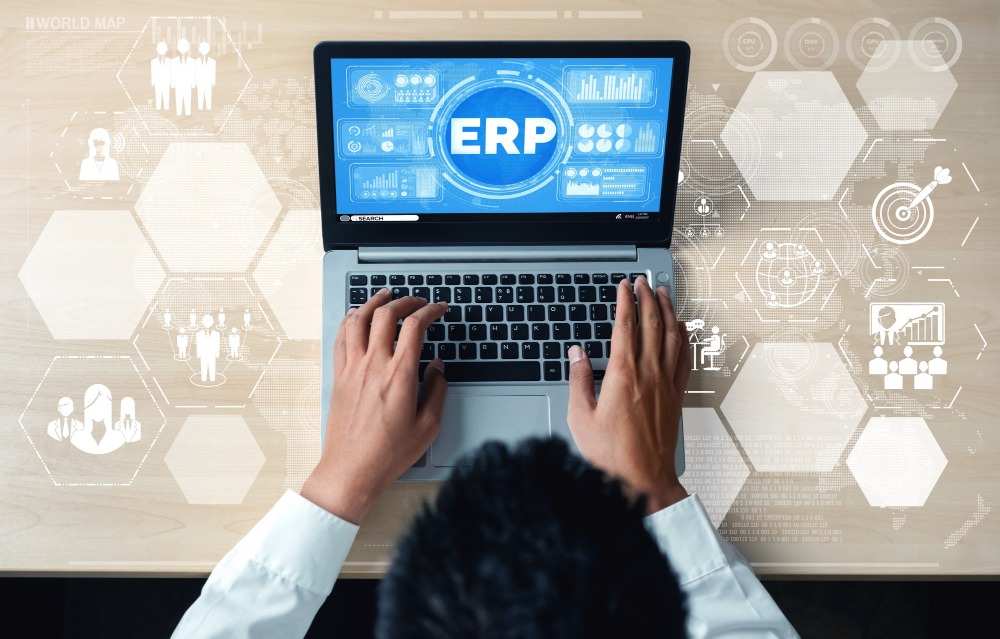In the ever-evolving landscape of business technology, Enterprise Resource Planning (ERP) systems have long been considered the backbone of organizational efficiency. These comprehensive software solutions promised to revolutionize how companies manage their core processes, from finance and human resources to manufacturing and supply chain operations. For many years, ERPs delivered on this promise, providing businesses with unprecedented levels of integration and standardization.
However, as we delve deeper into the digital age, a growing number of companies are finding that their once-cutting-edge ERP systems have become anchors, holding them back rather than propelling them forward. The very features that made traditional ERPs indispensable in the past are now often obstacles to growth, innovation, and agility in today’s fast-paced business environment.
This shift raises critical questions for business leaders: How exactly are legacy ERP systems limiting growth? What are the hidden costs and missed opportunities associated with sticking to outdated technology? And perhaps most importantly, how can companies break free from these constraints to position themselves for future success?
In this comprehensive exploration, we’ll delve into the multifaceted ways in which traditional ERPs are becoming liabilities rather than assets for growth-oriented businesses. We’ll examine the technical, operational, and strategic challenges posed by legacy systems, and shed light on the path forward for companies looking to thrive in the digital era.
The Rise and Fall of Traditional ERPs
To understand the current limitations of traditional ERPs, it’s helpful to look back at their origins and evolution. Enterprise Resource Planning as a concept emerged in the late 1980s and early 1990s, building upon earlier Material Requirements Planning (MRP) systems used in manufacturing.
The promise of ERP was compelling: a single, integrated software solution that could manage all core business processes. This would eliminate data silos, reduce duplicate data entry, improve data accuracy, and provide management with a holistic view of the business. For many organizations, implementing an ERP system was a transformative experience, bringing newfound efficiency and control to their operations.
Throughout the 1990s and early 2000s, ERP systems became increasingly sophisticated, expanding their reach into more areas of business operations. Industry giants like SAP, Oracle, and Microsoft dominated the market, offering comprehensive solutions that became the de facto standard for large enterprises across various sectors.
However, as we moved into the 2010s and beyond, the limitations of these systems began to show. The pace of technological change accelerated, with cloud computing, mobile technologies, artificial intelligence, and the Internet of Things (IoT) reshaping the business landscape. Many traditional ERPs, with their monolithic architectures and on-premises deployments, struggled to keep up with these rapid changes.
Today, while ERPs remain crucial for business operations, many organizations find themselves at a crossroads. Their legacy systems, once a source of competitive advantage, are now holding them back. Let’s examine the key ways in which traditional ERPs are limiting company growth.
The Shackles of Monolithic Architecture
At the core of most traditional ERP systems lies a monolithic architecture – a single, tightly-integrated application that handles all core business processes. This approach, while offering simplicity and consistency, has become a significant liability in today’s rapidly changing business environment.
Rigidity and Resistance to Change
Monolithic ERPs are notoriously difficult to update or modify. Even minor changes can require extensive testing and downtime, as the entire system must be taken offline to implement updates. This rigidity makes it challenging for businesses to adapt quickly to market changes or implement new processes.
Consider a company that wants to introduce a new product line with a unique sales process. In a monolithic ERP, this might require modifications that touch multiple modules – sales, inventory, finance, and more. The interdependencies between these modules mean that changes must be carefully coordinated and tested, a process that can take months and consume significant resources.
This lack of agility can be particularly damaging in industries characterized by rapid innovation or changing customer expectations. While more nimble competitors can quickly adjust their operations to seize new opportunities or respond to market shifts, companies constrained by monolithic ERPs often find themselves a step behind.
Complexity and Maintenance Challenges
As monolithic ERP systems grow and evolve over time, they tend to become increasingly complex. This complexity manifests in several ways:
- Codebase Bloat: Over years of use and customization, the codebase of a monolithic ERP can become unwieldy, making it difficult for developers to understand and maintain.
- Interdependencies: With all functions tightly integrated, changes in one area can have unforeseen consequences in others. This increases the risk of system-wide failures and makes troubleshooting more challenging.
- Performance Issues: As the system grows, performance can degrade. Scaling up to handle increased loads often requires scaling the entire application, even if only one module is under stress.
- Difficult Upgrades: The all-or-nothing nature of monolithic systems means that upgrades are often major undertakings, requiring significant downtime and risking disruption to business operations.
These factors combine to create a maintenance burden that grows over time. IT teams often find themselves spending more time and resources just keeping the system running, leaving less capacity for innovation and strategic initiatives that could drive growth.
The Burden of On-premises Deployment
Many traditional ERPs were designed for on-premises deployment, meaning they are installed and run on the company’s own hardware and infrastructure. While this approach offers a certain level of control and security, it comes with significant drawbacks that can impede growth.
High Upfront Costs and Ongoing Investments
On-premises ERPs require substantial upfront investment in hardware, software licenses, and IT infrastructure. This capital-intensive model can be particularly challenging for growing businesses, as it ties up funds that could otherwise be used for expansion, research and development, or other growth initiatives.
Moreover, as the business grows, these systems often struggle to scale efficiently. Expanding capacity typically means purchasing additional servers, storage, and licenses – a process that can be both expensive and time-consuming. This model of periodic large investments can strain company finances and create a lumpy cost structure that’s difficult to align with business growth.
Resource-Intensive Maintenance
Maintaining an on-premises ERP system requires a dedicated IT team with specialized skills. These professionals are responsible for a wide range of tasks:
– Hardware maintenance and upgrades
– Software patching and version updates
– Security management
– Backup and disaster recovery
– Performance tuning and optimization
As systems grow more complex over time, the resources required to keep them running smoothly can become a significant burden. This not only impacts the bottom line but also diverts valuable human resources away from innovation and growth-focused activities.
Limited Accessibility and Collaboration
On-premises systems can also limit a company’s ability to embrace modern work practices and collaboration tools. Remote access to these systems is often cumbersome, requiring VPN connections or other secure access methods. This can be a significant handicap in an era where remote work and global operations are increasingly common.
Furthermore, sharing data or integrating processes with external partners, suppliers, or customers can be challenging with on-premises systems. This limitation can hinder a company’s ability to participate fully in today’s interconnected business ecosystems, potentially missing out on growth opportunities that rely on seamless collaboration and data exchange.
The Trap of Vendor Lock-in
One of the most insidious ways traditional ERPs limit company growth is through vendor lock-in. Many legacy ERP providers design their systems with proprietary technologies and closed ecosystems, making it difficult for businesses to integrate third-party solutions or switch to alternative providers.
Limited Innovation and Flexibility
Vendor lock-in can severely constrain a company’s ability to innovate and adapt. As new technologies emerge – such as advanced analytics, artificial intelligence, or Internet of Things (IoT) devices – businesses find themselves unable to fully leverage these innovations without significant custom development work or expensive upgrades from their ERP vendor.
This limitation can be particularly damaging in fast-moving industries where the ability to quickly adopt new technologies can be a key differentiator. Companies locked into legacy ERPs may find themselves watching from the sidelines as more agile competitors seize new opportunities and capture market share.
Get in Touch
We know what NetSuite can do and how it can help you. Schedule your free NetSuite assessment today
Escalating Costs Over Time
With limited options for switching providers, companies often find themselves at the mercy of their ERP vendor when it comes to pricing for upgrades, support, and additional modules. This lack of leverage can lead to inflated costs over time, eating into budgets that could otherwise be allocated to growth-driving initiatives.
Moreover, the costs associated with staying within a vendor’s ecosystem can compound over time. As businesses grow and their needs evolve, they may find themselves purchasing additional modules or services from the same vendor, even if these solutions are not the best fit or the most cost-effective options available in the market.
Difficult and Costly Exits
Perhaps the most significant impact of vendor lock-in is the difficulty and expense of switching to a new system when the current one no longer meets the company’s needs. The process of migrating data, retraining staff, and reconfiguring business processes for a new system can be daunting, often requiring years of planning and execution.
This high barrier to exit can lead companies to stick with suboptimal systems far longer than they should, hindering their ability to adapt and grow. The fear of disruption and the sunk costs associated with the existing system can paralyze decision-making, keeping businesses trapped in increasingly outdated technology paradigms.
Scalability: The Achilles’ Heel of Legacy ERPs
As businesses grow, their ERP systems need to grow with them. Unfortunately, many traditional ERPs struggle
The limitations of on-premises hardware often mean that as data volumes increase and user numbers grow, system performance begins to degrade. This can lead to slower processing times, increased downtime, and frustrated users – all of which can have a direct impact on productivity and, ultimately, the bottom line.
For example, a company experiencing rapid growth might find that its month-end close process, which once took a day or two, now stretches to a week or more as the system struggles to handle the increased volume of transactions. This not only delays important financial reporting but also ties up key personnel who could be focused on growth-related activities.
Geographic Expansion Challenges
Many legacy ERPs were not designed with global operations in mind, lacking support for multiple currencies, languages, or region-specific regulatory requirements. As companies look to expand into new markets, they often find their ERP systems holding them back, necessitating costly and time-consuming workarounds or even parallel systems for different regions.
This limitation can significantly slow down international expansion efforts. A company might have to delay entering a new market while it figures out how to adapt its ERP system to handle local tax regulations or reporting requirements. In fast-moving global markets, such delays can mean missing out on crucial first-mover advantages.
Data Management and Analytics Limitations
As businesses grow, so does the volume and complexity of their data. Legacy ERPs often struggle to handle large datasets efficiently, both in terms of storage and analysis. This can limit a company’s ability to leverage its data for strategic decision-making and growth planning.
Moreover, many traditional ERPs lack the advanced analytics capabilities that are increasingly crucial for identifying growth opportunities and optimizing operations. While it may be possible to export data for analysis in other tools, this process is often cumbersome and can lead to delays in getting actionable insights.
The Customization Conundrum
Every business is unique, and ERP systems need to be tailored to fit specific organizational needs. However, customizing traditional ERPs is often a double-edged sword. While these systems do offer some level of customization, the process is typically complex, time-consuming, and expensive.
High Costs and Specialized Skills
Custom modifications to legacy ERPs often require specialized skills and deep knowledge of the system’s proprietary architecture. This not only increases the cost of customization but also creates a dependency on specific individuals or consultants who understand the customized setup.
For growing companies, this can create a significant bottleneck. As the business evolves and new requirements emerge, the ability to quickly adapt the ERP system becomes crucial. However, the scarcity of skilled resources and the high costs involved can slow down these adaptations, hindering the company’s ability to respond to new opportunities or changing market conditions.
The Technical Debt Trap
Heavy customization of legacy ERPs can lead to a phenomenon known as technical debt. As custom modifications accumulate over time, they can make the system increasingly brittle and resistant to change. This technical debt manifests in several ways:
- Upgrade Difficulties: Heavily customized systems often can’t easily accommodate vendor-provided updates and patches. Companies find themselves stuck on older versions, unable to take advantage of new features or security updates without undoing or redoing their custom work.
- Integration Challenges: Custom modifications can complicate efforts to integrate the ERP with other systems or adopt new technologies, as these integrations must work around or incorporate the custom elements.
- Knowledge Retention: As the architects of custom modifications leave the company or move on to other roles, vital knowledge about how these customizations work and interact with the core system can be lost.
- Increasing Complexity: Over time, layers of customization can make the system so complex that even small changes require extensive testing and carry high risks of unintended consequences.
This accumulation of technical debt can severely limit a company’s agility and ability to innovate, effectively anchoring them to outdated technologies and processes.
The Standardization vs. Customization Dilemma
Companies often find themselves caught between the need for standardization (to maintain system stability and ease of maintenance) and the desire for customization (to fit unique business processes). This dilemma can lead to suboptimal compromises:
– Overcustomization, resulting in a hard-to-maintain system
– Undercustomization, forcing the business to adapt its processes to fit the software rather than the other way around
– A patchwork approach, where some processes are heavily customized while others use out-of-the-box functionality, leading to inconsistencies and inefficiencies
Navigating this dilemma requires careful strategy and governance, capabilities that many growing companies struggle to develop and maintain when dealing with complex their promise of integration, many traditional ERPs have inadvertently created new data silos within organizations. As businesses grow and evolve, they often find that their ERP system doesn’t cover all their needs, leading to the adoption of additional specialized software solutions.
Fragmentd Data Landscapes
The limitations of legacy ERPs often force companies to adopt a variety of point solutions to meet specific needs. For example:
– A CRM system for managing customer relationships
– A separate HR management system for talent acquisition and performance management
– Specialized inventory management software for complex supply chains
– Advanced business intelligence tools for data analysis and reporting
While each of these systems may excel in its specific domain, they often don’t integrate seamlessly with the core ERP. This results in a fragmented data landscape where critical business information is spread across multiple systems, often with limited or no automatic synchronization.
The Impact on Decision Making
This fragmentation of data can have severe consequences for a company’s ability to make informed decisions and identify growth opportunities:
- Lack of Real-Time Visibility: When data is siloed, it becomes difficult to get a real-time, holistic view of the business. This can lead to delayed or suboptimal decision-making, particularly in fast-moving markets where timely information is crucial.
- Inconsistent Data: With information stored in multiple systems, discrepancies can arise. For example, customer information in the CRM might not match what’s in the ERP, leading to confusion and potential errors in order processing or financial reporting.
- Inefficient Reporting: Generating comprehensive reports often requires manually collating data from multiple systems, a time-consuming process that delays insights and increases the risk of errors.
- Missed Opportunities: Without a unified view of all business data, companies may miss important trends or opportunities that only become apparent when looking at the big picture.
Barriers to Collaboration
Data silos don’t just affect decision-making; they can also hinder collaboration within the organization. When different departments are working with different sets of data or using separate systems, it can lead to:
– Miscommunication and misalignment between teams
– Duplication of effort as multiple teams work with their own versions of the same data
– Difficulty in tracking end-to-end processes that span multiple departments
These collaboration challenges can be particularly damaging for growing companies, where agility and cross-functional teamwork are often key to seizing new opportunities and entering new markets.
Rigid Processes: A Barrier to Innovation
Traditional ERPs often come with predefined business processes based on industry best practices. While this can be beneficial for standardizing operations, it can also become a straitjacket that stifles innovation and agility.
The One-Size-Fits-All Problem
Many legacy ERPs were designed with a one-size-fits-all mentality, offering a set of standardized processes that were meant to work across a wide range of industries and company sizes. While this approach can work well for basic functions like accounting or order processing, it often falls short when it comes to the unique or innovative processes that give a company its competitive edge.
This rigidity can force companies to adapt their processes to fit the software, rather than the other way around. In some cases, this might mean abandoning efficient or innovative practices in favor of the ERP’s standard approach. For growing companies, particularly those in innovative or rapidly-evolving industries, this can be a significant handicap.
FAQs:
Traditional ERP (Enterprise Resource Planning) systems are integrated software applications designed to manage core business processes such as accounting, human resources, inventory management, and supply chain operations. These systems often operate on a monolithic architecture and are typically deployed on-premises.
Monolithic architecture means the ERP system is built as a single, tightly-coupled application. This makes it challenging to modify or update individual components without affecting the entire system, inhibiting agility and slowing down innovation.
On-premises deployment requires substantial investment in hardware, infrastructure, and IT personnel. This not only increases operational costs but also limits scalability, as businesses must plan and provision additional resources in advance to accommodate growth.
Vendor lock-in occurs when ERP vendors use proprietary technologies and data formats that trap customers within their ecosystem. This makes it difficult and costly for businesses to switch to alternative solutions, even if those solutions better meet their evolving needs.
Traditional ERPs often have trouble handling increasing volumes of data and supporting a growing number of users or business units. This scalability limitation can constrain a company’s ability to expand and meet growth demands.
Customizing traditional ERPs can be complex, time-consuming, and expensive. Over time, customizations can create technical debt, complicating upgrades and maintenance, and potentially leading to compatibility issues with future updates.
Data silos occur when information remains trapped within specific modules or applications. This fragmentation impedes business intelligence, hinders decision-making, and undermines cross-functional processes, affecting overall efficiency.
Traditional ERPs often struggle to integrate seamlessly with modern cloud-based applications and third-party tools. This lack of integration creates inefficiencies, duplicated efforts, and missed opportunities for leveraging innovative solutions.
Traditional ERPs are designed to standardize and automate processes, which can become rigid and inflexible over time. This rigidity makes it difficult for businesses to adapt to changing market conditions or customer expectations.
Businesses can migrate to cloud-based ERP solutions, adopt microservices architectures, and use agile methodologies. These steps enable on-demand scalability, reduce infrastructure costs, foster innovation, and enhance integration with modern applications, helping businesses unlock growth potential and maintain competitive advantage.







